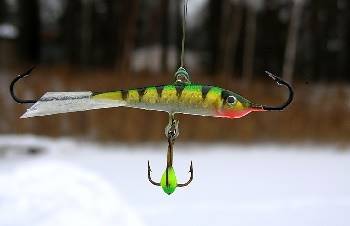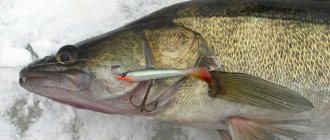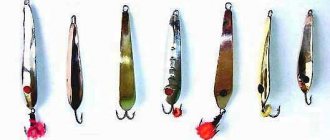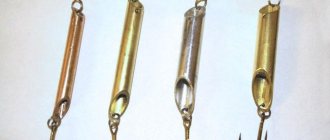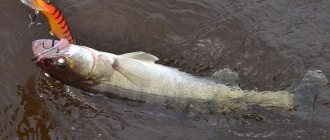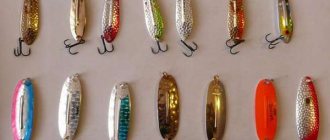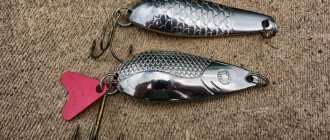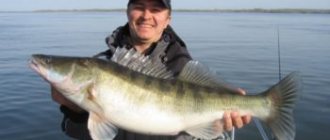The bullet spinner is a very catchy bait, which is used for winter and vertical fishing from a boat. You can also catch a bullet with a spinning rod using a jig. The bullet spoon is also called a cornbait and a pear.
Both small and large predators are caught with such a spoon; moreover, some fishermen even catch carp, crucian carp and roach with a bullet. But the main catch is still perch, pike and pike perch.
The peculiarity of the bullet spinner is that it is very shiny and noticeable from afar, and the hook is attached to the top of the bait, so during winter fishing you can tap the bottom with minimal chance of getting caught.
Fishing with a spinning rod
In open water, such a spoon can be fished well with a jig: pull, pause, pull. Or an option when, after the spoon falls to the bottom, two jerks are made. The idea is that the first jerk lifts you off the bottom, the second jerk is done halfway before the fall.
After the spoon falls, we wait a few seconds for the mud to settle and for the fish to have time to approach and examine the bait. Most often, bites occur on the falls themselves.
The jerks themselves are made with a spinning rod, the tip of which should work at 50-90 cm.
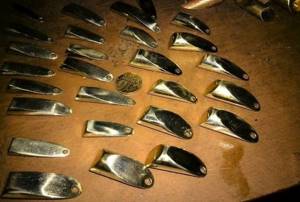
It is very important that the bullet lure shines well. We recommend polishing it with GOI paste.
The bullet can be tied in two ways:
- the tee hangs in a circle.
- the tee hangs down flat;
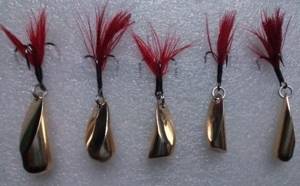
DIY bullet spinner
Making such a spinner is not easy, but exciting. The following tools and materials will be useful:
- Vise;
- Bulgarian;
- Drill (screwdriver);
- Files;
- Sandpaper;
- Paste GOI;
- Winding ring;
- Tee.
Spinner manufacturing process
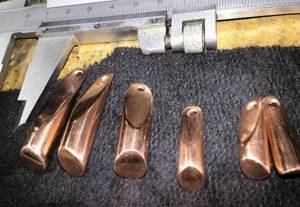
To make spinners, it is recommended to use loose brass; it is so called because during processing it crumbles into powder and not into shavings.
Take a piece of brass, clamp it in a vice and process it with a grinder or files on all sides so that the shape is appropriate. Then you sand with sandpaper of different grits (200, 400, 1000) and polish with GOI paste.
Drill a hole with a metal drill, remove the burrs, insert the winding ring into the hole, and insert the hook into it. The fishing line is also tied to the winding ring.
Method for making a “bullet” spinner
When to fish with bullets?

Author of the article: Vitaly Leonidovich Ivanov, 2021.
| How to choose a winter echo sounder | Fishing for perch on a bulldozer | Fishing with balance beams |
| Fishing with amphipods | Fishing with jigs | Review of drills for fishing |
| Fishing equipment | Choosing a winter suit | Pike fishing in winter |
|
|
|
|
|
|
|
|
|
|
|
|
|
|
|
|
|
|
|
|
|
|
Source: https://fisher-book.ru/563-blesna-pulya
Asp - fishing with a bullet
Today we will talk about asp. The asp is a kind of predator; when a school of bleak is detected, the asp quickly “crashes” into it, drowning out the small things with its powerful tail. But the hunt does not always bring results; a nimble bleak manages to avoid the jaws of a predator, and in order to satisfy its hunger, the asp spins around for a long time, looking for the runaway bleak, under bushes, near dams, going into the mouths of small streams and rivulets.
He also doesn’t mind eating insects such as grasshoppers, butterflies, and dragonflies. Experienced fishermen know the omnivorous nature of the asp and therefore use several types of baits simultaneously on one tackle, let him choose what he likes.
Many river fishermen use the following gear to catch asp:
I tie a “bullet” to the end of the fishing line, and above it, on a rigid leash, a fly (lead 1.5 - 2 cm). Who doesn’t know what a “bullet” is, it’s an olive-shaped piece of lead into which a tee is soldered on one side, and on the other a ring for a swivel, to which a fishing line is attached, the bait is about 5-6 cm long.
The weight of the bait also depends on the diameter of the “bullet”; it must be selected so that it can be cast further, to the maximum distance, with a spinning rod.
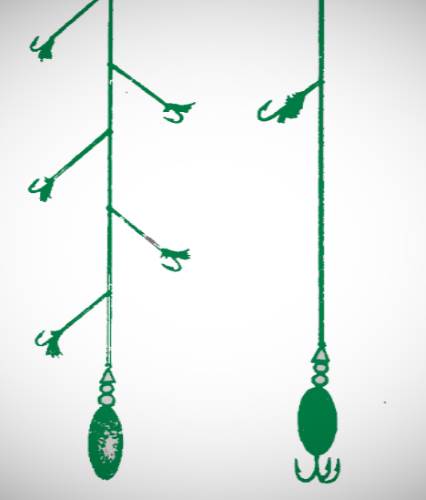
How to make a fly:
you need to choose a good (strong) hook size No. 8-10, with a long shank (the longer, the more convenient it will be to wind the feathers), as well as thread; The color doesn’t really affect it, but not white, 2-3 small feathers (preferably from small birds), we will need different feathers, in terms of color. When fishing, we don’t know what exactly the asp likes right now, so we make a supply of flies with a different selection of colors, and experiment with color while fishing.
When catching asp, they use fast retrieval of the bait, in the water the bait imitates how one fish is chasing another, a large fish is catching up with a small one, in our case it is the “bullet” that is catching up with the fly. This “duet” of two baits really attracts the predator’s attention, and he doesn’t have to wait long.
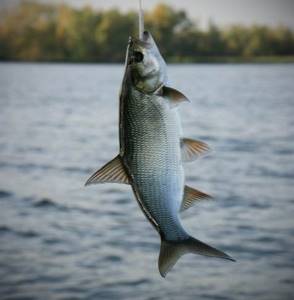
The most catchy time for catching an asp is the morning and evening dawns, at this time the predator fattens and is not particularly picky about the bait. It is not difficult to detect it, it gives itself away with powerful splashes, and you can see how after such a blow the fry “jump” through the water, or the bleaks jump out like frogs.
A large asp behaves very noisily on the river, unlike its small (up to half a kilogram) brother, this one resembles sabrefish, and prefers not to drown out the fry with its tail, but to pick it up on the riffles when it rolls into a hole, so it does not “scorch” like its large relative, but you can only notice the turbulence in the water from the constant diving of the asps for the fry.
Fishing for asp requires the fisherman to be extremely careful, so you need to approach the shore carefully, especially when he strikes close, if possible, you need to hide behind bushes or sedges, whatever you find, or just bend down. The asp is a very cautious fish (especially the larger ones), and if it notices you, the most “delicious” bait will no longer help.
It is bold when it is in a large school, and then far from the shore at a good depth. By the way, this fishing option is suitable for a novice fisherman who has decided to hunt this interesting predator. It is better for such a fisherman to look for schools of asp and not solitary fish.
In windy and cloudy weather, when there are ripples on the water and poor lighting, the asp barely sees the fisherman and therefore lets him closer and takes the bait more boldly. Of course, on such a day it is more difficult to detect a predator; sometimes it doesn’t even strike. But an experienced fisherman, peering into the distance, will always notice the subtle movements of the predator, where he turned around hunting for bleak.
When throwing a “bullet,” you need to calculate it so that it falls into the water not far from the place where the predator revealed itself, about 2-3 meters from the point where the fish hit. It is advisable to cast the bait upstream so that it is carried to the right place, not allowing it to go deeper, quickly begin to reel in the fishing line, leading the bullet with the fly at the surface of the water. If the fly jumps out of the water, this is even better; it attracts a predator more.
If, according to your observations, the asp stands in this place but does not take it, try changing the wiring, try holding it with pauses (like catching fish with a wobbler and not only), cast it - quickly reel it in - not a long pause so that the bullet goes a little deeper. Such wiring is sometimes very effective than conventional winding. That's all, good luck on the pond.
Bozhenov.A.V (B.A.V)
Category: Asp fishing
DIY bullet spinner
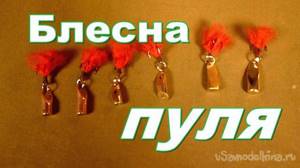
The opening of the open water fishing season is approaching; for those who have not had time to prepare for it during the long winter, it’s time to start. Today we will make a spinnerbait that is not difficult to make, called a bullet or a pear. There are rumors that this bait is very catchy, well, let's check it out. Necessary tools and equipment.
1. Angle grinder.2. Drill on stand.3. Industrial hair dryer.4. Drill 2 mm.5. Vise.6. Pliers.7. Scissors.8. Sharpening machine.9. Felt circle.10. Sandpaper.11. Paste GOI.
Materials needed.
1. Brass rod from the valve.2. Connector from a car camera.3. Copper tube with a diameter of 7 - 8mm.4. Sheet lead.5. Sheet asbestos.6. Red woolen threads.7. Fishing tees.8. Winding rings. To make these spinners we will need a brass or copper rod with a diameter of 7-8mm. A tube of the same diameter will also work. If you don’t have a rod or tube, you can use improvised materials, for example, a brass rod from a plumbing valve or a fitting from a car inner tube.
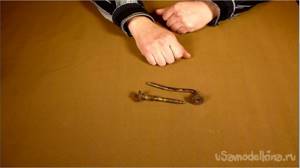
First, we clean the parts with sandpaper and polish them on a felt wheel using GOI paste. It is better to do this right away, since polishing small parts is much more difficult. We clamp the workpiece in a vice and make three cuts with a grinder, 90, 30-35 and 90 degrees.
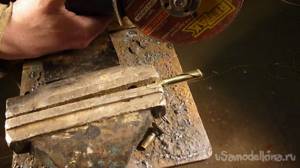
We get two blanks for spinners, one a little smaller, the second larger.
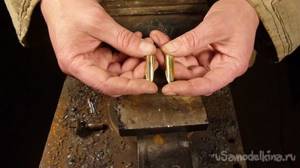
We clean the burrs, polish the cuts and drill holes for the winding rings. There is a little more work with the tube, since it needs to be filled with lead. After cutting the fitting from the camera, it turned out that it was made of a very thick-walled tube. It was decided to leave this tube as is, and fill a thinner-walled copper tube with lead. Cut off about 5-7 cm from the copper tube. We fill one end with wet asbestos. Be sure to dry the asbestos well with an industrial hair dryer. Cut the sheet lead into small pieces and fill the tube tightly. Warm up the tube with a hairdryer, when melting, the lead must add a little from time to time. To avoid heat loss, the tube from the vice can be insulated with the same asbestos. We also cut off the blanks, clear the burrs, polish the cuts and drill holes for the winding rings. Now you need to prepare the tees. We take a red woolen thread and cut two 5cm pieces from it. We thread the pieces into the eye of the tee and tie them with regular thread. We fluff the tails of the woolen threads with a needle. We attach the tees to the spinners using winding rings. We got six spinners of different sizes and weights. From a brass rod, 9g and 7.5g, from a brass tube, 6.5g and 4g, copper tube filled with lead, 8.5g and 7g.
How to make a spoon with your own hands / Spoons from a spoon, from a coin, from a tube
All winter, fans of spinning fishing have been waiting in the wings. And now, the time for fishing with summer bait has come. Some were purchased, while others were assembled by hand. Today we will learn how to use scrap materials to make a homemade bait from a dessert spoon, coins, a beer cap or a tin can lid.
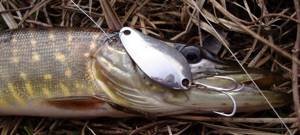
How to make a spinner with your own hands
You can make almost any spinner with your own hands. There are plenty of available materials for this: dessert spoons, metal plates and even coins. Let's look at some of the simplest options for creating the main types of spinners.
Oscillating spinners from a spoon
“Spoons” or oscillating spoons are a special type of metal bait made of a curved metal plate to which a hook is attached. The store sells a great variety of them, in various shapes and colors. However, we are not looking for easy ways, and today we will find out whether it is possible to make such a spinner yourself, what is needed for this, and how much time it will take.
After reading fishing forums and talking with professionals in this matter, we identified the easiest way to make a spoon at home - from an ordinary metal spoon.
The main thing here is to decide for yourself what size you need. Some people use the dining room, others the dessert room. The dining room is for hunting large trophies, the dessert room is for relatively small predators.
What do you need:
- Metal spoon;
- Balgarka or file;
- Metal drill;
- Winding rings.
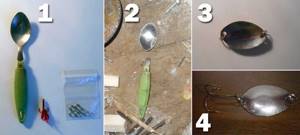
Manufacturing process:
- We prepare all the tools and ask my wife for a metal spoon.
- Use a grinder or a file to cut off the handle from the scoop.
- Drill two holes at the top and bottom. One for attaching a leash or fishing line. The second is for attaching the hook. Insert the winding rings.
- If desired, we sand the resulting lure or paint it in any color you like.
Rotating spoons from scrap materials
This type of spinner consists of two elements - a petal, thanks to which the spinner rotates, and a core, on which the petal and hook are attached. When animated by a spinning rod, the petal rotates around the core, and the fish pays attention to the bait. Let's look at the two simplest options for making such rotators.
Option #1. What do you need:
- Metal plate;
- Metal scissors;
- Metal drill;
- Bearing ball;
- Lead base for mold;
- Hammer;
- Beads;
- Wire with a diameter of 0.6 mm - 0.8 mm.
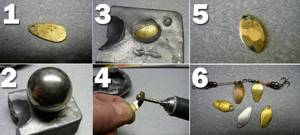
Manufacturing process:
- We take a metal plate and cut out a blank of the required length and width. We drill one hole in the upper part of the future petal.
- We take a ball from a bearing of the required diameter, place it on the surface of a lead blank, and, using a hammer, knock out the sphere.
- We place our petal into the resulting sphere, press it with the same ball from the bearing and hit it with a hammer. The metal plate becomes curved.
- Sand until shiny.
- You can give the petal facets. To do this, we place it on the same ball from the bearing, and tapping the petal with a hammer, we get edges.
- We take the wire, mount the winding ring on one edge, and attach a tee to it. Next, we put a sinker and 1 bead on it. Then we mount our petal through a clamp, or directly through a pre-drilled hole. We bend the wire.
Option No. 2
This method of making rotating spinners with your own hands is very original. As we managed to find out, this bait works great for perch, which is not whimsical and attacks almost everything that moves under water.
What do you need:
- Metal plug;
- Old spinner spoon;
- Lead balls;
- Pliers.
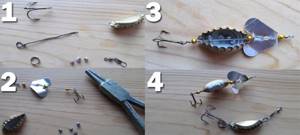
Manufacturing process:
- We take the old “rotator” and remove the load from it. Use pliers to roll up the beer cap so that you can put lead balls inside it.
- We reassemble the spoon, leaving space between the tee and the petal for the beer cap.
- We put the resulting structure onto the core of the spinner, and squeeze the plug all the way. We put balls inside. “Close” the plug with pliers. The main thing is not to overdo it - the balls should dangle freely inside.
- The noise bait made from scrap material is ready.
Bullet SILVER SHIN
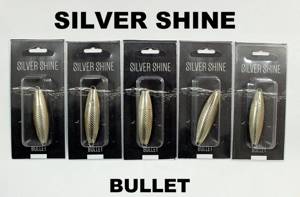
. It has been considered the most favorite among Samara fishermen for many years and today has not lost its relevance. The spinner has the shape of a bullet, which allows it to be thrown at a distance of 100 meters, and in some conditions even more. It is resistant to currents and does not go astray when playing.
Basic methods of wiring “SILVER SHIN Bullets”:
1. For a splash.
This method is used when there is an asp fight. The bait should be sent not exactly at this splash, but slightly ahead of the asp’s fight, so that the predator does not suspect otherwise and, when feeding, subsequently collides with the spoon. In such cases, lighter baits are used than when used against the current.
2. Across the stream or drifting.
This method is effective when fishing riffles. With it, you need to choose the right casting angle in order to correctly fish the entire area, using bait of a suitable weight.
3. Against a strong current.
This method is useful if there is a strong current in the intended location and the cast comes from the top point of the stream. This type of wiring dictates the use of heavy and compact baits.
Fishing tackle pear, or bullet

In this video lesson we will look at a unique fishing tackle called a pear, sometimes called a corn, or a bullet. They are mainly made of brass and lead, but any metal can be used. For example, you can take a copper tube, pour lead into it and give it the desired shape. Used for spinning fishing for perch, pike perch, silver carp, and carp.
Craftsmen buy inventions from the best Chinese online store.
On some days, fish are caught better on yellow brass rigs, on other days on red copper rigs, and sometimes they bite more actively on white iron rigs. How to make a pear?
Let's consider an example when a black iron rod is used as a workpiece. It is clamped in a vice, markings are made - 2 oblique lines. Using a grinder or a hacksaw, the rod is sawed along the marks. Next you need to round the corners, edges, and sand the workpiece.
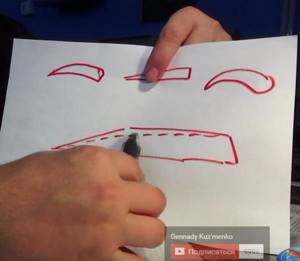
Smooth transition on the bag
There are many options for modifying the pear. As a rule, a smooth transition is made on one side. You shouldn't do anything complicated with this bait. It is catchable with the simplest processing. However, there is still plenty of room for creativity for every fisherman.
DIY electronics in a Chinese store.
Methods for equipping a pear with a tee
The first method is the simplest. The lurex thread is wound around the finger and cut. Then we direct some of the threads in one direction, and some in the other. We cut off a piece of thermophyte, this is a tube that shrinks when heated. We put it on the tee and warm it up with a lighter. The panicle is fixed.
You can simply wind the thread and fix it with varnish.
Which tee is better on the bag?
There is no need to grind with a tee. It should protrude beyond the edges of the bulb so that the fish clings well. This is the main criterion for choosing its size.
Tuning threesome with fur.
The fur in the water will play lively and sway. Instead of fur, you can use another suitable material. We take the three-piece and insert it into the vise. The plane should coincide with the eyelet. We wind the thread.
Cut out a piece of red fur, apply it and secure it with thread. All that remains is to fix it with superglue. If desired, you can make a light accumulating point. Tuning will be even more interesting with two-color fur.
Source: https://izobreteniya.net/ryibolovnaya-snast-grushka-ili-pulya/
When to fish with bullets?
Related articles:
| DIY fishing crafts | |
| Review of the best balancers for ice fishing |
| Fishing with jigs: varieties, gear, fishing techniques | |
| Types of fish finder echo sounders for fishing | |
| Review of aluminum fishing boats | |
| How to choose a spinning reel? | |
| Electric motors for inflatable boats (review) | |
| Aluminum fishing boats | |
| Which coil to choose for a feeder - overview of characteristics | |
| Characteristics and capabilities of feeder rods | |
| Fishing boat: what to look for when purchasing | |
| How to choose a motor for a boat? |
I noticed one interesting bait - a bullet spinner
.
It is also called pear
or
corn
. There is reason to believe that it should work against both large and small predators.
The peculiarity of the “bullet” spinner is that the hook is attached to the top of the spinner, which allows you to tap the body of the spinner on the bottom without fear of getting caught. When fishing with a bullet in the summer, you can use a jig with a spinning rod - pull, the bullet falls to the bottom, pull again. It is quite tempting to try this method in the harsh Primorsky and Vologda conditions.
Interest in the bullet was caused by a series of videos about its production and use, which were made by fishermen from the Sudachek team (their video channel is at the link). The manufacturing process is quite simple - you will need a drill, a grinder, a set of files and sandpaper. In conditions of constant rise in price of spinners, making them yourself is a noble matter for the budget. I suggest watching a video about the features of using a bullet-pear-corn: when, where and on whom, and then about making it yourself and the features of equipping bullets with hooks.
How to use a bullet for catching pike, pike perch, etc.
In this video, the guys will tell you how, when and who you can catch with this type of lure.
Spinner “bullet”: video about making it yourself
The process of making a spinner-bullet in several versions is in the videos below.
The first option for making a bullet with your own hands
Second manufacturing option
An example of how to work with a spinner on the water (wiring, spinning, etc.) in the following video:
Features of equipping spinners with hooks (double and treble hooks), as well as examples of adding various types of cambrics, braids, etc. to the hooks are in the following detailed and fairly long video at the link.
In conclusion, I would like to add that work on testing pear, bullet and corn spinners has also begun in Doblesny Primorye, the material has been purchased, we will try it and be sure to share the results.
In this video lesson we will look at a unique fishing tackle called a pear, sometimes called a corn, or a bullet. They are mainly made of brass and lead, but any metal can be used. For example, you can take a copper tube, pour lead into it and give it the desired shape. Used for spinning fishing for perch, pike perch, silver carp, and carp.
On some days, fish are caught better on yellow brass rigs, on other days on red copper rigs, and sometimes they bite more actively on white iron rigs. How to make a pear?
Let's consider an example when a black iron rod is used as a workpiece. It is clamped in a vice, markings are made - 2 oblique lines. Using a grinder or a hacksaw, the rod is sawed along the marks. Next you need to round the corners, edges, and sand the workpiece.
There are many options for modifying the pear. As a rule, a smooth transition is made on one side. You shouldn't do anything complicated with this bait. It is catchable with the simplest processing. However, there is still plenty of room for creativity for every fisherman.
Methods for equipping a pear with a tee.
The first method is the simplest. The lurex thread is wound around the finger and cut. Then we direct some of the threads in one direction, and some in the other. We cut off a piece of thermophyte, this is a tube that shrinks when heated. We put it on the tee and warm it up with a lighter. The panicle is fixed.
You can simply wind the thread and fix it with varnish.
Which tee is better on the bag?
There is no need to grind with a tee. It should protrude beyond the edges of the bulb so that the fish clings well. This is the main criterion for choosing its size.
Tuning threesome with fur.
The fur in the water will play lively and sway. Instead of fur, you can use another suitable material. We take the three-piece and insert it into the vise. The plane should coincide with the eyelet. We wind the thread. Cut out a piece of red fur, apply it and secure it with thread. All that remains is to fix it with superglue. If desired, you can make a light accumulating point. Tuning will be even more interesting with two-color fur.
In the world of sport fishing, this is one of the most famous types of spinners. Its inventor is Vladimir Matveychikov, whose name it bears. Although its form looks very simple, its stable performance will not disappoint you. Designed for winter perch fishing at a depth of one and a half to five meters.
Let's dwell on what kind of wiring should be here. The main method is a combination of a sharp rise and a free release. There are small-frequency oscillations here, which are combined with a smooth falling game. This game is effective not only with a good bite, but also in the dead of winter. To increase efficiency, you can vary the height of the swing or toss, you can get different styles of play from glider to nail.
It is designed for fishing in weak or no currents. Its enormous popularity is due to both its high catchability and the ease with which it can be made yourself. This spoon was originally created for sport fishing.
It’s quite possible to do it yourself. Here we will look at making a spinner weighing three grams. First, let's look at its drawing.
As we can see, the form is quite simple and does not seem to raise any questions
We list the materials that we will need in the manufacturing process:
- Copper sheet half a millimeter thick. Its dimensions should be sufficient to cut a part two centimeters wide and four meters long.
- The hook we are using here is Owner no.
- A piece of thin steel wire two centimeters long or the eye of a pin. This is necessary to make a loop to which the fishing line will be tied.
- Solder POS-40 and soldering acid. We will attach both the hook and the fastening loop to the tackle using a soldering iron.
- Sandpaper. You will also need GOI polishing paste. The fully manufactured product must be processed in this manner.
Step by step guides
Now we will describe in detail each step of making the Matveychikov spinner:
First you need to prepare a copper sheet for work.
To do this, draw a straight line along its middle with a sharp object. Now you will need to measure 13 millimeters from the edge of the line and draw a perpendicular segment.
We will make notches at a distance of 5 millimeters from the center line. It will look like this.
Now let's bend the sheet at a right angle along the original straight line. Let's step back 1 millimeter from the center line and draw a straight line through the previously marked notch.
Let's make the other three cuts in the same way. We get the following.
Now we need to process our workpiece using a file and a needle file. At this stage, it is necessary to carefully round off the sharp corners. Approximately at a distance of a third of the length from the side of the short part of the product, you need to slightly bend it towards the fold.
Now you need to treat the surface of its inner part. The result of our work must be thoroughly cleaned with sandpaper.
Next we will work on the crochet. First you need to use wire cutters to bite off the loop. The hook shank must be cleaned with sandpaper. After that it needs to be tinned. Having done this, let’s put it aside for now.
Now let's start attaching the loop to the spoon. Here one of two main options is usually used. To do this, you can use the eye of a pin or take a small piece of wire from a steel cable. In our case, we will use the second option. Let's twist the eyelet out of the wire core. It looks like this.
The fastening will need to be tinned using solder. Solder a loop on the inside of the long and narrow part. Now take the previously prepared hook and solder it on the inside of the short part of the spinner. Let's add some more solder here. We'll get something like this.
Everything is almost ready. You just need to sand the edges and the entire surface of the product with sandpaper. After this treatment, all that remains is to apply the GOI polishing paste.
This is what a fully manufactured Matveychikov spinner will look like.
Purchase
The manufacturer GOA offers a classic version of this spinner for 300 rubles. There are several options on sale to choose from.
- Options for the material from which it is made. Cupronickel-brass.
- Cupronickel-copper.
- Nickel.
- Brass.
- Copper.
- Single soldered hook.
Reviews
Alternatives to Matveychikov's spinner
This spoon is designed for winter fishing. It is very effective, but this option is not the only one. Let's talk about what other options there are for winter fishing. Let's talk about those spinners that you can make yourself and that have proven themselves well.
This spoon is cut from sheet brass. Effective for winter fishing for perch at a depth of up to eight meters.
The game of this spinner is stable and free-flowing. When cutting from a sheet, you need to make a trapezoid about 40 millimeters high, with a wide side of 9 and a narrow side of 6 millimeters. To give it a shape, we place it on a thick piece of lead and put something like a dowel (3.5 - 3 millimeters in diameter). Give shape with gentle blows of a hammer. Using a soldering iron, attach the loops.
With its help you can successfully catch perch or pike perch at a depth of up to 20 meters.
There is also a tube spinner. As follows.
With its help they catch pike perch. Made from stainless steel. The hole was made by drilling. The cutting took place in a circle 1 millimeter thick.
The next variety is called “Petersburg sleeper”. Made from two strips: copper and brass. Effective for catching perch. You can also use a treble hook here.
We will also mention here the classic diamond-shaped spoon.
Made from brass. Used for perch at a depth of up to five meters. Of course, in this list we cannot do without mentioning the classic Matveychikov spinner, which was previously described in this article.
Matveychikova spinner. Drawing and instructions for self-production Link to main publication
- Editorial
- about the project
Do-it-yourself bullet spinner, video selection
Hello friends, the OPRS 25 Bears team noticed one interesting bait - a bullet spinner . It is also called pear or corn. There is reason to believe that it should work against both large and small predators.
The peculiarity of the “bullet” spinner is that the hook is attached to the top of the spinner, which allows you to tap the body of the spinner on the bottom without fear of getting caught. When fishing with a bullet in the summer, you can use a jig with a spinning rod - pull, the bullet falls to the bottom, pull again. It is quite tempting to try this method in the harsh Primorsky and Vologda conditions.
Interest in the bullet was caused by a series of videos about its production and use, which were made by fishermen from the Sudachek team (their video channel is at the link). The manufacturing process is quite simple - you will need a drill, a grinder, a set of files and sandpaper.
In conditions of constant rise in price of spinners, making them yourself is a noble matter for the budget.
I suggest watching a video about the features of using a bullet-pear-corn: when, where and on whom, and then about making it yourself and the features of equipping bullets with hooks.
How to use a bullet to catch pike, pike perch, etc.
In this video, the guys will tell you how, when and who you can catch with this type of lure.
Spinner “bullet”: video about making it yourself
The process of making a spinner-bullet in several versions is in the videos below.
The first option for making a bullet with your own hands
Second manufacturing option
An example of how to work with a spinner on the water (wiring, spinning, etc.) in the following video: Features of equipping spinners with hooks (doubles and tees), as well as examples of adding various types of cambrics, braid, etc. to the hooks in the following detailed and a fairly long video at the link.
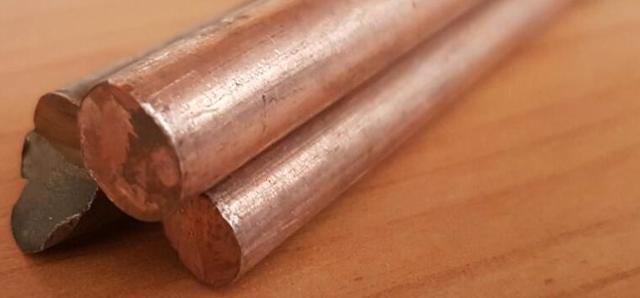
In conclusion, I would like to add that work on testing pear, bullet and corn spinners has also begun in Doblesny Primorye, the material has been purchased, we will try it and be sure to share the results.
Source: https://25medvedey.ru/blesna-pulya-svoimi-rukami-video.html
Zander flashing in winter
Catching pike perch in winter with a tube spoon is very effective. The catchability indicator of this type of spinner is excellent. Winter options can be made from silver metal or metal with a yellow, reddish sheen. For example, from aluminum and copper tubes.
In addition to playing with types of metal, you need to make blanks with different cuts - angles of attack. The cuts can be made in one direction, parallel or at different angles. You can also do it with cuts in different directions. The so-called “junction and separation”.
Have you already made a spinner tube for pike perch with your own hands? Or did you buy a whole arsenal of such lures in the store? Then it's time to go fishing! You can catch a medium-sized pike perch or get a trophy fish worth several tens of kilograms in the waters of the Volga. Fishing fans will find the Sazanya Bay fishing base in Astrakhan. It uniquely combines natural conditions and comfortable accommodation.
